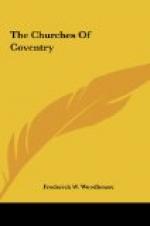In 1451 he made the city with the villages and hamlets within its liberties into a county “distinct and altogether separate from the county of Warwick for ever,” and in 1453 the King and Queen again visited the Priory. Perhaps out of gratitude for all this royal favour, Coventry adhered to the Lancastrian cause and in 1459 was chosen as the meeting place for the “Parliamentum Diabolicum,” so called from the number of attainders passed against the Yorkists. The year 1467 however saw Edward IV and his Queen keeping their Christmas here, while less than two years later her father and brother were beheaded on Gosford Green (Aug. 1469).
After the king’s landing at Holderness in 1471 the king-maker, declining a contest, occupied the town for the Lancastrians, and Edward passing on to London soon after turned and defeated the earl at Barnet. After Tewkesbury Edward paid the city another visit, and in return for its disloyalty seized its liberties and franchises, and only restored them for a fine of 500 marks. Royal visits still continued. Richard III came in 1483 to see the plays at the Feast of Corpus Christi; in 1485 Henry VII stayed at the mayor’s house after his victory at Bosworth Field; and in 1487 kept St. George’s Day at the Monastery, when the Prior at the service cursed, by “bell, book, and candle,” all who should question the king’s right to the throne. The importance of the Gilds is shown by the king and queen being made a brother and sister of the Trinity Gild; and the part that pageantry played in the lives of all men is seen in the many occasions on which kings and princes came hither to be entertained, not only with the plays “acted by the Grey Friars” but those in which the “hard-handed men” of, for instance, the Gild of the Sheremen and Tailors, “toil’d their unbreathed memories” in setting forth such subjects as the Birth of Christ and the Murder of the Innocents. But although Henry VIII himself was received in 1511 with pageantry




